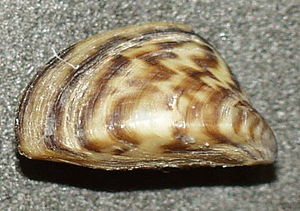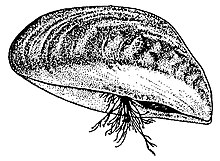Wandering mussel
| Wandering mussel | ||||||||||||
|---|---|---|---|---|---|---|---|---|---|---|---|---|

Wandering mussel ( Dreissena polymorpha ) |
||||||||||||
| Systematics | ||||||||||||
|
||||||||||||
| Scientific name | ||||||||||||
| Dreissena polymorpha | ||||||||||||
| ( Pallas , 1771) |

The migrating mussel ( Dreissena polymorpha ), also known as the zebra mussel , is one of the representatives of the autolamellibranchiata , a subclass of the class of mussels (bivalvia). It is one of the few freshwater mussels that go through a free-swimming larval stage.
Appearance
The hiking mussel is characterized by its characteristic triangular, boat-like shape. It reaches a length of 26–40 mm with a width of 17–20 mm. The shells are dark brown to black in color, broken up by light brown stripes.
origin
The earliest documented evidence of the migrating mussel in Europe comes from the Miocene (5.3–23 million years ago). The population in Europe steadily decreased until the 18th century . After that, due to shipping traffic, re-immigration from the Black Sea started up the Danube. The mussels attach themselves to ship hulls or enter the new habitat as larvae via the ballast water of the ships. Since then, there have been several waves of colonization with numbers of up to 100,000 animals per square meter. Because of the worldwide shipping traffic, the migrating mussel has been spreading increasingly in the great lakes of North America since the 1980s . Thanks to its strong filter effect, the depth of view in Lake Erie has doubled.
Problem
The migrating mussel is a very competitive species that attaches itself to aquatic plants and large mussels. This leads to a strong spread and disturbance of the natural biodiversity of the ecosystems . According to this, it is an invasive form of the neobiota . Ducks and waterfowl and especially carp, on the other hand, benefit from this new source of food.
In addition, damage to cooling water systems due to fouling in pipes and heat exchangers is increasing sharply. However, such contamination can be reliably prevented by high-performance filters . In addition, it is known that potassium chloride has a toxic effect on mussels without any similar negative effects on other aquatic organisms.
Bioindicators
Wandering mussels serve as bioindicators for the limnic ecosystem . Among other things, they are particularly suitable as bioindicators because they
- are widespread
- a broad ecological valence as well
- have a sedentary way of life,
- are in close contact with all ingredients dissolved and suspended in the water
- Absorb pollutants directly from the water.
That is why they have been collected, archived and analyzed for various environmentally relevant substances by the federal environmental specimen bank for years . In this way, for example, changes in the methylmercury content can be examined and conclusions can be drawn about the environmental quality.
Saprobic index
The saprobic index of the migrating mussel is 2.2.
literature
- Ian J. Killeen, David Aldridge, Graham Oliver: Freshwater bivalves of Britain and Ireland. (Occasional publication Field Studies Council, 82). 114 pp., Field Studies Council, Shrewsbury 2004, ISBN 1-85153-892-5 .
- Zadory, Lilla (1983) Room evaluation with the help of a migrating mussel. Geosciences in our time; 1, 3; 86-89; doi: 10.2312 / geosciences . 1983.1.86 .
Individual evidence
- ↑ M. Rossbach, JD Schladot and P. Ostapczuk: Specimen Banking , Springer-Verlag, Berlin, Heidelberg, 1992.
- ↑ Gerhard Wagner et al .: Guideline for sampling and sample processing: Dreikantmuschel (Dreissena polymorpha) (draft) (PDF; 346 kB) Federal Environment Agency, January 2003.
- ↑ Krause, M., Reher, S., Rüdel, H .: Methylmercury Concentrations in Triangular Clams and Mussels - Pollutant Measurement in the Framework of the Federal Environmental Specimen Bank. Annual meeting of the Society of German Chemists, Munich, 7. – 8. October 2003 ( summary at the Fraunhofer Institute for Molecular Biology and Applied Ecology ).
- ↑ Meyer, Detlef .: Macroscopic biological field methods for assessing the water quality of rivers: with lists of species for beginning and experienced investigators and detailed descriptions and images of the indicator organisms . 4th, unchanged. BUND, Hannover 1990, ISBN 3-9800871-4-X .
Web links
- Dreissena polymorpha inthe IUCN 2013 Red List of Threatened Species . Posted by: Van Damme, D., 2011. Retrieved February 13, 2014.

